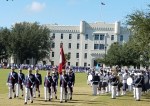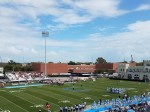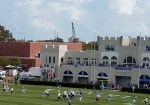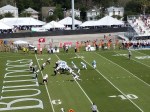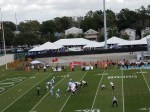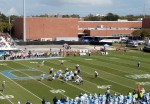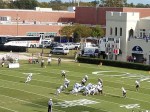This week, The Citadel’s football team travels to Macon, Georgia, for a matchup with Mercer.
For a brief period of time, I lived in Georgia. With all due respect to the great Ray Charles, my memories of the state invariably involve an overflowing Flint River…
—
– The Citadel plays another ranked team on Saturday, this time on the road
– Colby Kintner is the SoCon Special Teams Player of the Week
– The Citadel’s Monday press conference
– Brent Thompson’s radio show (with video breakdown)
– Mercer head football coach Drew Cronic’s radio show
– Streaming: ESPN3, with Pete Yanity on play-by-play and Jared Singleton handling analysis
[ Edit: an alert reader has pointed out that the game is listed by Mercer, the SoCon, and ESPN’s own website as streaming on ESPN3, as opposed to ESPN+.
If you’re confused (and you should be), this explainer might be of assistance: Link ]
– Radio: Luke Mauro and Lee Glaze call the game online and also on three radio stations statewide: WQNT (102.1-FM/1450-AM) in Charleston, WQXL (100.7-FM/1470-AM) in Columbia, and WDXY (105.9-FM/1240-AM) in Sumter.
—
Weather forecast: per the National Weather Service, it should be sunny on Saturday afternoon in Macon, with the high temperature approaching 87°.
—
The Citadel is 3-5 all-time in games played on September 17; four of those eight matchups were shutouts (two for the Bulldogs, two for the opposition).
The most recent game played by the program on that date was a 31-24 victory at Gardner-Webb in 2016, a contest in which the Bulldogs only completed one pass. There will have to be a few more receptions by The Citadel’s pass-catchers this week if the Bulldogs are to come home from Macon with a win.
—
Computer ratings:
– SP+ ranks Mercer 37th in FCS, while The Citadel is 82nd. Projected score: Mercer 33.3, The Citadel 16.1.
– Massey ranks Mercer 31st in FCS, with The Citadel 52nd. Projected score: Mercer 31, The Citadel 21, with the Bulldogs given a 27% chance of pulling the upset.
– Congrove ranks Mercer 22nd, and The Citadel 79th. Congrove doesn’t project a score, but favors Mercer by 14.78 points (with a 3-point bump for home field).
– Laz Index ranks Mercer 17th in the subdivision, with The Citadel 59th. There is no score projection here either, but the Bears have a 10.07-point edge in Laz’s power rating.
– DCI ranks Mercer 27th, and The Citadel 74th. Projected score: Mercer 37.14, The Citadel 19.88.
—
FCS Rankings:
– FCS Coaches’ Poll: Mercer 20th, The Citadel unranked [no votes]
– Stats Perform FCS Top 25: Mercer 20th, The Citadel unranked but receiving votes [would be 32nd]
– FCS Nation Top 25: Mercer 14th, The Citadel 24th
I’m including the FCS Nation Top 25 on the roundup this week, not as much because The Citadel is ranked in that particular poll, but by virtue of Mercer using it as part of its ticket sales push:
As kickoff approaches on Saturday night at Five Star Stadium, #20/#23 Mercer will be coming off a bye week while the Bears’ opponent, The Citadel, got the attention of everyone in the Southern Conference upsetting the defending SoCon champion and #8 ETSU, 20-17, on a walk-off field goal. As a result, the Bulldogs moved into the Top 25 in the FCS Nation Radio rankings…
In addition to the Bears playing their first SoCon game of the 2022 season on Saturday at 6 p.m., an outstanding lineup of performers is set to hit the stage in Toby Town for the Ford Concert Series. For those who have not nabbed their ticket for the game, here is one more opportunity.
…A 24-hour flash sale will be held from 8 a.m. on Tuesday, Sept. 13 until 8 a.m. on Wednesday, Sept. 14. One ticket purchased for $10.01 will grant admission into the Mitchell Tenpenny pregame concert as well as the Mercer vs. The Citadel football game.
(I believe that release by Mercer came out just before this week’s FCS Coaches’ Poll was released. The Bears are 20th in that poll, not 23rd as stated in the quoted section.)
—
Other games involving SoCon teams:
– Wofford at Virginia Tech (11 am ET kickoff; Terriers have yet to score this season)
– Cornell at VMI (an important game for the SoCon; we’re all fans of the Keydets this week)
– Presbyterian at Western Carolina (Catamounts should win handily; PC only beat VUL by eight points last week)
– North Alabama at Chattanooga (another non-conference contest of note; the league could use a Mocs victory)
– Samford at Tennessee Tech (road games can be tricky, but SU is the better team)
– Furman at East Tennessee State (the week’s other league matchup)
—
A few other FCS games worth mentioning:
– Holy Cross at Yale (Ivy League starts play this week)
– Colgate at Penn
– Gardner-Webb at Elon (Runnin’ Bulldogs gave Coastal Carolina all it wanted last week)
– Incarnate Word at Prairie View A&M
– North Dakota at Northern Arizona
– Sacramento State at Northern Iowa
– Delaware at Rhode Island
– North Dakota State at Arizona (yes, NDSU is favored)
– Montana State at Oregon State (Beavers are good but still only 13½-point favorites)
– Tennessee State at Middle Tennessee State (Hmm…)
– Missouri State at Arkansas (Bobby Petrino Bowl)
– Stony Brook at Massachusetts (Stony Brook is favored in a couple of places)
—
Stats of note through The Citadel’s first two games of the season:
| Average (2 gms) | Opponents | The Citadel |
| Field Position | 38.50 | 24.26 |
| Success Rate | 47.7% | 39.8% |
| Big plays (20+ yards) | 3.5/gm | 2.5/gm |
| Finishing drives (average points) | 3.25 | 4.29 |
| Turnovers | 1.0/gm | 1.5/gm |
| Expected turnovers | 0.47/gm | 1.08/gm |
| Possessions | 9.0/gm | 9.5/gm |
| Points per possession | 2.56 | 1.58 |
| Offensive Plays | 55.5/gm | 61.5/gm |
| Yards/rush (sacks taken out) | 6.31 | 4.08 |
| Yards/pass attempt (including sacks) | 6.81 | 6.33 |
| Yards/play | 6.52 | 4.41 |
| 3rd down conversions | 38.1% | 33.3% |
| 4th down conversions | 75.0% | 75.0% |
| Red Zone TD% | 40.0% | 60.0% |
| Net punting | 27.33 | 32.13 |
| Starting FP after KO | 27.43 | 23.60 |
| Time of possession | 24:05/gm | 35:55/gm |
| TOP/offensive play | 26.04 | 35.04 |
| Penalties/P-yds | 9.0/82.5 yds | 10.5/77.0 yds |
| 1st down passing | 64.7%, 8.72 yds/pa | 60.0%, 7.20 yds/pa |
| 3rd and long passing | 40.0%, 5.10 yds/pa | 33.3%, 1.25 yds/pa |
| 4th down passing | 100.0%, 11.00 yds/pa | 66.7%, 12.67 yds/pa |
| Passing on “passing downs” | 50.0%, 7.41 yds/pa | 50.0%, 5.56 yds/pa |
| 1st down yards/play | 6.73 | 5.23 |
| 3rd down average yards to go | 8.71 | 7.22 |
| Defensive 3-and-outs+ | 3.0/gm | 1.0/gm |
– ‘Finishing drives’ is a category for all drives that feature a first down inside the opponent’s 40-yard line. It is a natural (and sometimes more illuminating) extension of the ‘Red Zone’ concept. The Citadel’s defense has done a good job in its own territory so far, with more “bending” than “breaking”.
– This week, I am adding the numbers for “passing downs”, which are defined as follows: 2nd-and-8+ yards, 3rd-and-5+ yards, and 4th-and-5+ yards.
– The Citadel has a negative field position differential of over 14 yards, which is a problem. The Bulldogs are at almost -4 yards on kickoff differential, but the net punting has (somehow) been in the military college’s favor, at +4.8. That is due mainly to no opposing punt return yards for Bulldog opponents, combined with Dominick Poole’s 50-yard scamper versus ETSU.
The real culprit when it comes to The Citadel’s field position woes? Arguably, that would be the six 3-and-out+ drives the Bulldogs’ offense has had through two games (31.5% of all possessions). Conversely, opposing offenses have only had two such drives (11.1%).
It is crucial that The Citadel’s offense begins converting 3rd down attempts at a higher rate. A few more big plays wouldn’t hurt, either.
– The Bulldogs also need to fix their early-season penalty problems (although opponents have been flagged at a high rate as well).
—
Participation report:
The Citadel had 43 players compete on the field against East Tennessee State last Saturday. Two of them were “true” freshmen — offensive lineman Sawyer Whitman, who made his first career start, and holder Jack McCall (somewhat curiously listed as a long snapper on the online roster). Whitman and McCall also saw action versus Campbell.
Both are South Carolina natives. Whitman went to Gaffney High School, while McCall is a product of Hammond School (located in Columbia).
—
As we all know, there are certain college football media members who frequently advocate for the elimination of FBS vs. FCS games. This same group tends to also cheerlead for anything that gets the sport closer to the Superleague.
In the past, however, there haven’t really been many high-profile FBS coaches or administrators who have gone on record emphatically defending those contests, with the notable exception of Jimbo Fisher.
That has changed recently. First, Georgia head coach Kirby Smart had this to say prior to his team’s game against Samford last week:
“High schools are our feeder programs, just like we are for the NFL. And if you’re going to have good high school programs, you got to have kids getting opportunities to play at all levels. Because there’s a lot more kids playing at a non-Power 5 level than at the Power 5 level. So if you’re a supplier of talent and the growth of the game comes from your youth sports and your high school sports, you’re going to diminish that as these programs fade away.”
There was a similar article in The Athletic on Smart’s comments that also mentioned some of the other benefits of the cross-subdivision games, including the frequently-overlooked fact that an FCS matchup is often a chance to attend a game at a lower cost, which can be very important to families (and is an outcome that many college administrators want, as it broadens the fan base).
This week, the Lexington Herald-Leader posted a story on Kentucky’s upcoming game against Youngstown State, with quotes from Kentucky AD Mitch Barnhart and head football coach Mark Stoops.
Barnhart:
“It’s important to support FCS football because I want people participating in college football. I think sometimes we forget about thinking about the end game, making sure everybody is still playing. If there’s opportunities that go away and there’s not kids that want to play the game of football, the game of football suffers. We’ve got to make sure we do things that ensure the game of football and people want to play the game. Keeping FCS football alive is very, very important to that end. We like playing one of those games. That’s important to us.”
Stoops was also supportive, stating that FCS teams “compete and depend on these games as well. I like supporting them in that area.”
It appears the SEC schools will continue playing FCS opponents (with the exception of South Carolina playing The Citadel, of course). That will remain the case even after that conference inevitably moves to a 9-game league slate, which I anticipate happening once Texas and Oklahoma start playing an SEC schedule. This is good news.
—
Mercer’s online roster includes 80 players from Georgia. Other states represented: Florida (6 players), North Carolina (6), South Carolina (5), Alabama (4), Tennessee (3), Pennsylvania (2), and one each from California, Nebraska, New York, and Ohio. Redshirt freshman defensive lineman Emil Hovde is a native of Gothenburg, Sweden.
Fourteen of the Bears began their college careers at other four-year institutions (eight of them enrolled at Mercer this summer). The schools represented on that list: Alabama A&M, Coastal Carolina (3 players), East Carolina, Gardner-Webb, Georgia, Georgia State, Jacksonville State, James Madison, Lenoir-Rhyne, Morehouse, South Alabama, and South Carolina.
—
Mercer is 1-1 so far this season; this game will mark its SoCon opener. The Bears previously defeated Morehead State, 63-13, and lost at Auburn, 42-16.
MU was off last week, so the Bears have had two weeks to prepare for Saturday’s contest.
Mercer will go on the road next week to face Gardner-Webb, its final non-conference regular-season game in 2022. Future non-conference opponents for the Bears include Mississippi, Morehead State, and Yale (all in 2023, the latter two matchups at home) and a 2024 contest at Alabama.
A few Mercer players to watch:
– Senior quarterback Fred Payton (6’2″, 220 lbs.) is in his second year as MU’s starting signal-caller after beginning his college career at Coastal Carolina. In 12 games at Mercer, Payton has completed 58.1% of his passes, averaging 8.49 yards per attempt (not counting sacks against), with 18 touchdowns and 10 interceptions.
– Right tackle John Thomas (6’3″, 300 lbs.) was a preseason first-team All-SoCon pick. The junior is one of three returning starters for the Bears on the o-line; the new faces up front are the left guard and right guard (a sophomore and redshirt freshman, respectively).
Mercer’s projected starters on the offensive line average 6’2″, 276 lbs.
– MU had ten different players run the football against Morehead State, which was not particularly unusual; the Bears had eight players carry the pigskin versus The Citadel last fall.
Austin Douglas (6’0″, 208 lbs.), a transfer from James Madison, has led Mercer in rushing in both of its games this season. Against Morehead State, he rushed for 140 yards.
– Wide receiver Ty James (6’2″, 200 lbs.) was named the FCS national offensive player of the week (for the games of Week 0) after a scintillating performance versus Morehead State. James, who spent one year at UGA before moving south to Macon, had five receptions for 192 yards and 3 TDs in that contest.
Another wideout, Devron Harper (5’9″, 168 lbs.), had two TD catches against Auburn.
Tight end Drake Starks (6’3″, 240 lbs.) had a 75-yard touchdown reception on the first play from scrimmage in the spring 2021 game between Mercer and The Citadel.
– Seven MU players who started last November’s game against The Citadel return this year, including first-team all-SoCon safety Lance Wise (5’9″, 195 lbs.). Wise led Mercer in tackles in both games versus the Bulldogs in 2021, and also returned a fumble for a TD in the 2019 contest (a game eventually won by The Citadel).
– Linebacker Isaac Dowling (5’10, 225 lbs.) was a preseason second-team all-conference selection. He had nine tackles against the Bulldogs last fall.
– Another preseason second-team all-league choice on the Bears’ defense is Solomon Zubairu (6’1″, 255 lbs.). The weird thing about that is Zubairu was actually a first-team All-SoCon pick by both the coaches and media after the fall 2021 campaign, during which he had five sacks. I’m not sure what he did wrong during the offseason.
– Punter Trey Turk (6’2″, 195 lbs.) was also a preseason second-team all-SoCon selection, based mostly on making the league’s all-freshman team last year, but possibly in part because “Trey Turk” is a cool name for a punter.
—
It is hard to get a sense of how good Mercer is this season based on its first two games, which were against a non-scholarship D1 squad and an SEC team. However, the Bears have a lot of returning production from last season, a campaign in which MU won 7 games (6 in the SoCon) and probably merited an at-large bid to the FCS playoffs.
One of those wins came against The Citadel, a 34-7 result in Johnson Hagood Stadium. In that contest, Mercer ran on 71.9% of its offensive plays from scrimmage, averaging 6.3 yards per carry (one of which was a 72-TD run by Tayshaun Shipp, one of only five rushing attempts he had all season).
Defensively, Mercer forced three turnovers and held the Bulldogs to 4.0 yards per play. The Citadel did not score after the first quarter.
It also doesn’t hurt the Bears that they have had an extra week to prepare for the triple option.
—
Another week, another ranked opponent. That is life in the SoCon, where there are no gimmies.
The challenge for the Bulldogs is to maintain their excellent play last week in Charleston (particularly on defense), but to do it in a road setting.
While a difficult task, it isn’t an impossible one. Many of the players on this year’s squad know the feeling of beating a good team on the road, because that’s just what The Citadel did in the final game of 2021 when the Bulldogs won at Chattanooga.
It might come as a little bit of a surprise to some that The Citadel has actually won three consecutive league games, dating back to last season. Two of them have been against programs in the upper echelon of the conference.
This isn’t a “little engine that could” situation. The Bulldogs should play with confidence and a fair amount of aggression. It would also help to get off to a good start.
I’m looking forward to Saturday.
Filed under: Football, The Citadel | Tagged: FCS, Mercer, SoCon, The Citadel | 1 Comment »















